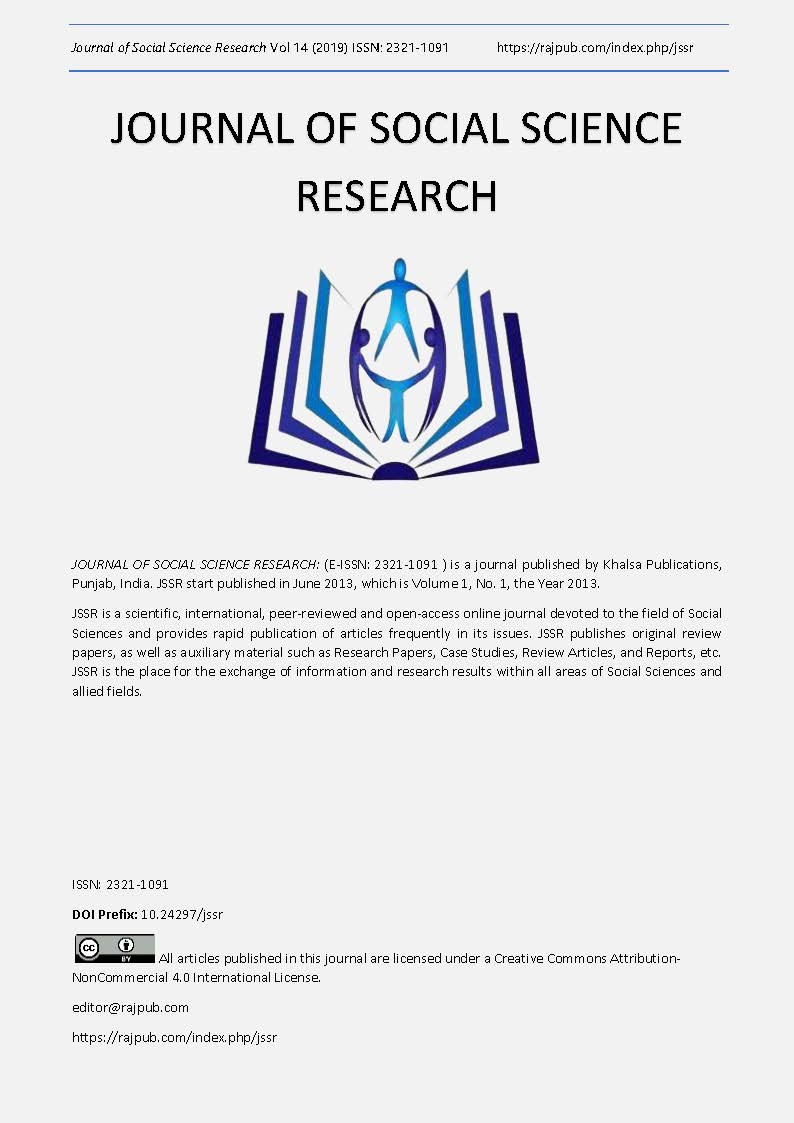India Maritime Strategy Towards China
DOI:
https://doi.org/10.24297/jssr.v14i0.8342Keywords:
Act East Policy, Chins, India, Indian Ocean, Maritime SecurityAbstract
The strategic value of Indian Ocean has invited lots of attention from a major power. For India, the Indian Ocean shows its domain and obvious superiority that it has held for some centuries. However, there seem to be an arise from China presence in the region. This action has prompted India as the leading actor in the area and created a diversified approach to mitigating the issue. How should India respond to this? What would be the impact of this phenomenon on India maritime strategy? Is China presence should be defined as a threat for India to continue its ambition as a prospect dominant global key player, or it produces opportunity that India should grab in order to remain relevant in Indian Ocean perspective. The objective of this article is to discuss the actions taken by India to enhance its national interest in the India Ocean. This qualitative approach has using secondary data from 2010- 2018. The finding of this study are 1) India has come out with a maritime strategy to counterbalance China, 2) the Act east policy appeared to be a soft power for India to pursuit more strategic goals as compared to the previous Look East policy which seems to be typically rhetoric and concentrated on economic friendship, 3) India continues to develop cooperation with the superpower and major power countries such as the United States, Australia and Japan.
Downloads
References
Callahan W.A., 2005. Forum: The Rise of China; How to understand China: the dangers and opportunities of being the rising power. Review of International Studies 31. 701–714. Doi. Retrived on January 19, 2019 from doi:10.1017/S0260210505006716.
Cohen, S. P., & Dasgupta, S. (2013). Arming without aiming: India's military modernization. Brookings Institution Press.
DeSilva-Ranasinghe, S. (2011). India’s Strategic Objectives in the Indian Ocean Region. In the Workshop Report(Vol. 20).
Ghoshal, B. (2009). India, Southeast Asia, and the FTA: Strengthening Economic Integration. IPCS Issue Brief, (114).
Global Security. (2018) Access at https://www.globalsecurity.org/military/world/india/in-navy-development.htm. On 3rd May 2018.
Guha, S. (2016). Post ASEAN Summit, India is Ready to Project its Naval Presence in Asia-Pacific Region. Firstpost.com. Access at https://www.firstpost.com/world/post-asean-summit-india-is-ready-to-project-its-naval-presence-in-the-asia-pacific-region-2999790.html on 21st July 2018.
Khan, R.M. (2012). Global ambitions of Indian Navy. Pakistan Observer, Nov 15, 2012. Access at http://pakobserver.net/detailnews.asp?id=30150 on 13th Jun 2018.
Lakshmi, R. (2018). India and U.S. deepen defense ties with a landmark agreement. Washington
Post Online. Access at https://www.washingtonpost.com/world/india-and-us-deepen-defense-
ties-with-landmark-agreement/2016/08/30 on 23rd July 2018.
Ladwig III, W. C. (2016). Drivers of Indian naval expansion. In The Rise of the Indian Navy (pp. 33-54). Routledge.
Levesques, A. (2018). Wuhan summit edges India and China towards a new strategic understanding.
IISS. Access at https://www.iiss.org/blogs/analysis/2018/05/wuhan-india-china-strategic on
21st July 2018.
Lee, L. (2015). India as a Nation of Consequence in Asia: The Potential and Limitations of India's' Act East'Policy. The Journal of East Asian Affairs, 29(2), 67.
Mearsheimer, J. J. (2010). The gathering storm: China’s challenge to US power in Asia. The Chinese
Journal of International Politics, 3(4), 381-396.
Medeiros, E. S. (2005). Strategic hedging and the future of Asia?pacific stability. Washington
Quarterly, 29(1), 145-167.
Medcalf, R. (2012). Unselfish giants? Understanding China and India as security providers. Australian
Journal of International Affairs, 66(5), 554-566.
Mohan, C. R. (2006). India and the Balance of Power. Foreign affairs, 17-32.
Naidu, G. V. C. (2004). Whither the look east policy: India and Southeast Asia. Strategic
Analysis, 28(2), 331-346.
Nayar, B. R., & Paul, T. V. (2003). India in the world order: searching for major-power status.
Cambridge University Press.
Pant, H. V. (Ed.). (2016). The rise of the Indian Navy: internal vulnerabilities, external challenges. Routledge.
Pant, H. V., & Joshi, Y. (2015). The American" Pivot" And The Indian Navy: It's Hedging All the Way. Naval war college review, 68(1), 47.
Poddar and Yi, E. (2007). India's Rising Growth Potential. BRICs and Beyond, ed. Goldman Sachs Global Economics Group. New York, NY: Goldman Sachs
Rourke, R. (2018). China Naval Modernization: Implications for U.S. Navy Capabilities Background and Issues for Congress, CRC Report for Congress, Washington D.C.
Rehman, I. (2016). India’s aspirational naval doctrine. In The Rise of the Indian Navy (pp. 69-93). Routledge.
Rice, C. (2000). Promoting national interest. Foreign Affairs, 45-62.
Saksena, A.R. (2014). India’s Urgent Needs for Defence Modernisation. The Diplomat. Access at https://thediplomat.com/2014/11/indias-urgent-need-for-defense-modernization/ on 2nd Mac 2018.
Sikri, R. (2009). India's “Look East” Policy. Asia-Pacific Review, 16(1), 131-145.
Singh, S. (2015). Exercise Malabar: Japan Navy to Join India, the US int he Bay of Bengal. The Indian Express.
Singh, S. (2018). How China-consciousness defines Malabar 2018. AsiaTimes. Access at http://www.atimes.com/how-china-consciousness-defines-malabar-2018-exercises/ on 21st July 2018.
Scott, D. (2007). Strategic imperatives of India as an emerging player in Pacific Asia. International Studies, 44(2), 123-140.
Trading Economic team. (2018). India Military Expenditure. Access at https://tradingeconomics.
Com/india/military-expenditure on 7th July 2018.
Trading Economic team. (2018). China Military Expenditure. Access at https://tradingeconomics.
Com/China/military-expenditure on 7th July 2018.
Yergin, D. (2006). Ensuring energy security. Foreign affairs, 69-82.
Holmes, J & Yoshihara, T., 2010. Understanding Asia-Pacific Sea Power, The Diplomat dated 21 Oct
2010 (online) access at http://the-diplomat.com/2010/10/21/asia-pacific-sea-power/ on 9 July
2018.
Ministry of Foreign Affairs of the People’s Republic of China. (2018). Foreign Ministry Spokesperson Geng Shuang's Regular Press Conference on November 27, 2018. Retrieved on February 1,
2019 at https://www.fmprc.gov.cn/mfa_eng/xwfw_665399/s2510_665401/2511_665403/t1616746.shtml
ET Online. (2018). Malabar exercise: India, US Japan go submarine-hunting in a veiled warning to
China. Access on 26th July 2018 at https://economictimes.indiatimes.com/news/defence/malabar-exercise-india-us-japan-go-submarine-hunting-in-a-veiled-warning-to-china/articleshow/59530971.cms
Downloads
Published
How to Cite
Issue
Section
License
 All articles published in Journal of Advances in Linguistics are licensed under a Creative Commons Attribution 4.0 International License.
All articles published in Journal of Advances in Linguistics are licensed under a Creative Commons Attribution 4.0 International License.




